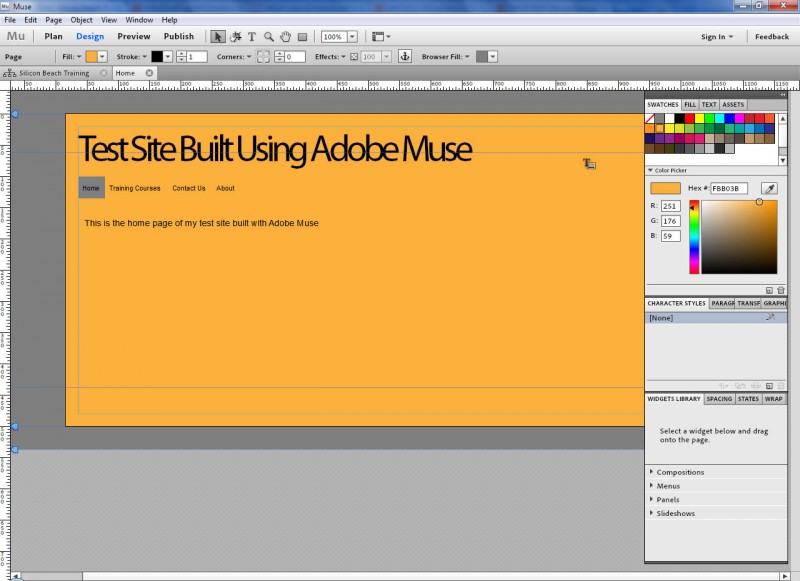Aaron Charlie
22 Aug 2011
Adobe Muse - The New Dreamweaver?
 Well well well - it seems that Adobe can't stop releasing previews and betas at the moment!
Well well well - it seems that Adobe can't stop releasing previews and betas at the moment!
We recently saw the unveiling of Adobe Edge - a potential future replacement for Flash which creates animations using HTML5. You might like to check out my summary of Adobe Edge (and my atrocious attempt at an animation).
Then last week, they also lifted the lid on Adobe Muse. Muse is a "code name" - so we wait with baited breath to see what the final product will be called. Adobe is currently "working with the branding team to determine the final name of this product" (perhaps the developers are fans of the Devon rock band of the same name!)
Whatever it ends up being called - Muse is a web design tool that allows designers without any coding experience to create website designs and publish them without having to look at any HTML. It's a What You See is What You Get (WYSIWYG) tool.
Hang on a minute though! Adobe already has the industry standard WYSIWYG web design tool on its books in the shape of Dreamweaver - which has been around for a LONG time (we've been running web design training since 1999 and our Dreamweaver course was the first Silicon Beach Training ever offered!)
Dreamweaver was originally released in the age of static HTML pages - and has had to reinvent itself over the years to keep up in the age of dynamic database driven websites. It hasn't done a bad job of that, and remains a very useful design tool and code editor (Dreamweaver CS5.5 also includes tools for mobile authoring - which is the biggest growth area in web design at the moment). But - to use Dreamweaver effectively to produce dynamic sites which include blogs, social integration etc... (all of which are really important now), increasingly requires more coding experience.
This is where blog and web design CMS systems like Wordpress and Joomla have come in to their own in recent years. Via simple interfaces and easy to use plugins, these tools allow people with genuinely NO programming experience to set up sites with interaction and social integration. They are theme based, and don't have as much flexibility in terms of layout design as Dreamweaver - but nevertheless can deliver professional results.
So who is Adobe Muse for, and what can it do?
Adobe Muse's strapline is "Create websites as easily as you create layouts for print" - so it's clear that this product is aimed squarely at print designers who want to build websites (the tool was created by the team behind InDesign)
We've downloaded the beta, and the interface will certainly be familiar to all you Photoshop and InDesign users out there:

OK - so far so good - Muse is a kind of "Dreamweaver lite" with a more designer-friendly interface. I had a quick play, and without having to follow any tutorials quickly made a very simple 4-page site using a master page.
Muse also has a simple "publish" function (rather than an FTP client like Dreamweaver), which allows you to either export your site in HTML format locally, or to publish directly to the web via a "Business Catalyst" account. Including this 'instant 1-click publish to the web' functionality seems to indicate that Muse wants to compete with CMS systems like Wordpress et al... and fill a gap in the market for designers who want to be able to realise their design vision without having to employ a web designer or learn how to customise Wordpress themes.
Will Adobe Muse Succeed?
There's undoubtedly a demand for this sort of product - but how will it shape up against the other options?
Wordpress is brilliant and simple to use - but doesn't allow flexibility in terms of designing the 'look and feel' of a site unless you can build custom templates (which requires programming knowledge).
Dreamweaver has lots of functionality and allows more design flexibility, but doesn't allow the simple addition of interactive features like blogs, user commenting and social integration using plugins.
Muse will be a welcome addition for anyone who's ever designed a website layout in Photoshop and then thought - "how do I turn this in to a website"!
BUT
(and its a big but!)
Muse currently has NO facility to add user interaction (blogs & comments) OR social integration (Facebook, Twitter & Google+ share buttons etc...)
Now - it's early days - this is a beta version and you would expect Adobe are going to add a lot more functionality to the product. But on current evidence, Muse is going to be a tool that builds static HTML pages - and we're really not sure if that's going to cut the mustard in the current market.
We'll keep following Muse's progress - we'd love to hear your thoughts too - comment below!
